Bernanke Says Financial Firms Should Pay for Bank Closings Costs Not Tax Pay
Stock-Markets / Financial Markets 2009 Oct 24, 2009 - 04:03 AM GMT Federal Reserve Chairman Ben S. Bernanke called on Congress to ensure that the costs of closing down large financial institutions are borne by the industry instead of taxpayers. The Fed chairman called for a “credible process” for imposing losses on the shareholders and creditors, saying “any resolution costs incurred by the government should be paid through an assessment on the financial industry.”
Federal Reserve Chairman Ben S. Bernanke called on Congress to ensure that the costs of closing down large financial institutions are borne by the industry instead of taxpayers. The Fed chairman called for a “credible process” for imposing losses on the shareholders and creditors, saying “any resolution costs incurred by the government should be paid through an assessment on the financial industry.”
Bernanke’s remarks coincide with central bank efforts to step up supervision of banks and crack down on compensation practices that fuel excessive risk-taking. As Congress considers the biggest overhaul of financial regulation since the 1930s, Bernanke said it’s “critical” for lawmakers to close regulatory gaps and provide supervisors with the tools to manage risks throughout the financial system. Could that be because the FDIC is broke?
China’s recovery on a sugar high?
On Oct. 22, Beijing announced that gross domestic product grew by 8.9% in the third quarter of 2009 compared with the corresponding period last year. The National Bureau of Statistics also reported that growth for the first three quarters was up 7.7%.
The economy picked up during this year's second quarter, when it expanded 7.9%. Now it is clear that China will attain for 2009 at least the 8% target that Premier Wen Jiabao set in January. China's leadership is evidently satisfied. As the State Council noted on Wednesday, "The positive trend of recovery has been consolidated." (Read full article for the surprise ending.)
Is the stock market rolling over?
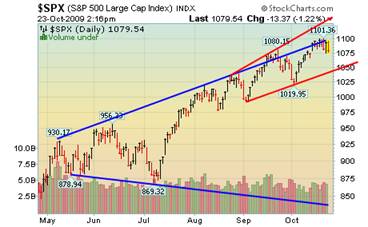 --Earnings season is in full swing. The primary mantra in all but the blue chip company reports is “not as bad as we thought it would be.” However, that can only go so far when the primary cause of earnings has been mass layoffs in the work force. Most of the pleasant surprises came in the second quarter, the “second derivative,” where one-time cost cutting measures produced a better result than expected. There’s not much water left in that well.
--Earnings season is in full swing. The primary mantra in all but the blue chip company reports is “not as bad as we thought it would be.” However, that can only go so far when the primary cause of earnings has been mass layoffs in the work force. Most of the pleasant surprises came in the second quarter, the “second derivative,” where one-time cost cutting measures produced a better result than expected. There’s not much water left in that well.
Treasuries are getting no traction. 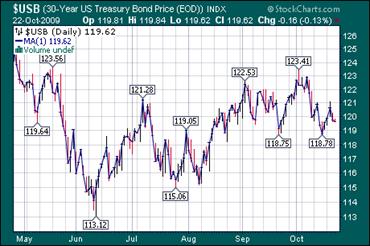 -- Treasuries fell for a second day as the U.S. announced plans to sell a record $123 billion of notes and inflation-protected debt next week and an industry report showed an index of U.S. leading indicators advanced more than forecast. The yield spread between the two- and the 10-year notes widened to 247 basis points with the majority of the securities being sold maturing in five years and more.
-- Treasuries fell for a second day as the U.S. announced plans to sell a record $123 billion of notes and inflation-protected debt next week and an industry report showed an index of U.S. leading indicators advanced more than forecast. The yield spread between the two- and the 10-year notes widened to 247 basis points with the majority of the securities being sold maturing in five years and more.
The gold rally may be losing steam.
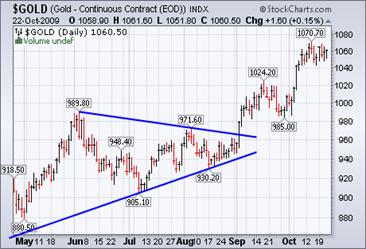 --Gold, little changed today in Asia, is on track for a fourth weekly gain as a weaker dollar boosted investor demand for the precious metal as a store of value.
--Gold, little changed today in Asia, is on track for a fourth weekly gain as a weaker dollar boosted investor demand for the precious metal as a store of value.
Bullion is up 0.8 percent this week as Dollar Index, which tracks the greenback against the currencies of six trading partners including the euro and yen, slid 0.8 percent. Some investors buy gold as a hedge against a declining U.S. currency.
Will the Nikkei continue its rally?
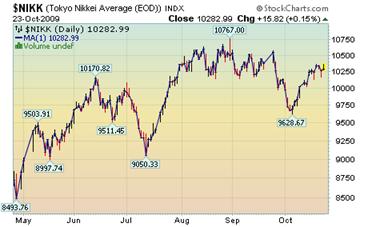 - Japanese stocks fell as concern Japan Airlines Corp. shareholders will be hurt by a turnaround plan and banks will be forced to raise new capital overshadowed expectations corporate earnings will improve.
- Japanese stocks fell as concern Japan Airlines Corp. shareholders will be hurt by a turnaround plan and banks will be forced to raise new capital overshadowed expectations corporate earnings will improve.
Japan Airlines, Asia’s biggest carrier, slumped 6.7 percent after the Nikkei newspaper said banks are pushing to have some shares of the company canceled, which would reduce shareholder equity.
But is China’s recovery real?
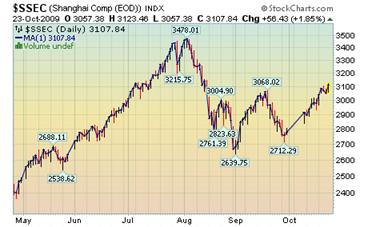 -- The Shanghai index rose, driving the benchmark index to a third weekly advance, as financial companies and automakers gained on speculation the government will continue stimulus measures to cement the economic recovery. The Shanghai index has surged 71 percent this year as $586 billion of stimulus spending and record loans of $1.27 trillion helped the nation’s economy rebound from the deepest slump in almost a decade. Gross domestic product grew 8.9 percent in the third quarter from a year earlier, the fastest pace in a year, the government reported yesterday.
-- The Shanghai index rose, driving the benchmark index to a third weekly advance, as financial companies and automakers gained on speculation the government will continue stimulus measures to cement the economic recovery. The Shanghai index has surged 71 percent this year as $586 billion of stimulus spending and record loans of $1.27 trillion helped the nation’s economy rebound from the deepest slump in almost a decade. Gross domestic product grew 8.9 percent in the third quarter from a year earlier, the fastest pace in a year, the government reported yesterday.
The dollar’s demise brings notion of $1 million bill.
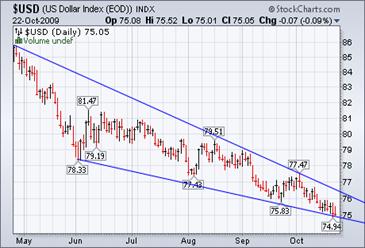 Forty years ago, the U.S. government said the $100 bill would be the highest-denomination note. With the Federal Reserve now trying to print its way out of the financial crisis, it may be time to revisit that decision. Reinstating $10,000 or $100,000 notes -- which existed in limited fashion years ago -- won’t cut it. In today’s, “Brother, can you spare a trillion dollars?” economy, we need to think bigger -- a $1 million bill may be in order.
Forty years ago, the U.S. government said the $100 bill would be the highest-denomination note. With the Federal Reserve now trying to print its way out of the financial crisis, it may be time to revisit that decision. Reinstating $10,000 or $100,000 notes -- which existed in limited fashion years ago -- won’t cut it. In today’s, “Brother, can you spare a trillion dollars?” economy, we need to think bigger -- a $1 million bill may be in order.
Real estate could get uglier.
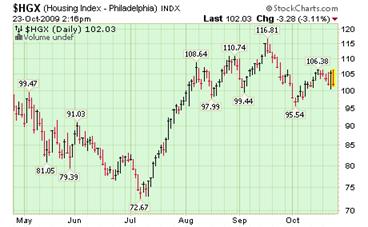 -- Despite some tentative signs of recovery, the U.S. housing market remains vulnerable to further price drops—especially in areas where large numbers of mortgages are headed toward foreclosure over the next few years. The Wall Street Journal's quarterly survey of housing-market data in 28 major metro areas shows sharp drops in the number of homes listed for sale across the country. But the potential supply of homes is far larger because banks are likely to acquire significant numbers of foreclosed homes over the next few years.
-- Despite some tentative signs of recovery, the U.S. housing market remains vulnerable to further price drops—especially in areas where large numbers of mortgages are headed toward foreclosure over the next few years. The Wall Street Journal's quarterly survey of housing-market data in 28 major metro areas shows sharp drops in the number of homes listed for sale across the country. But the potential supply of homes is far larger because banks are likely to acquire significant numbers of foreclosed homes over the next few years.
Crude inventories are not rising as expected.
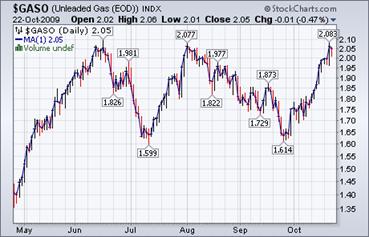 U.S. crude oil inventories rose last week slightly less than forecast while gasoline stockpiles fell more than expected, weekly government oil data showed Wednesday.
U.S. crude oil inventories rose last week slightly less than forecast while gasoline stockpiles fell more than expected, weekly government oil data showed Wednesday.
U.S. weekly gasoline stockpiles dropped 2.3 million barrels to 206.9 million barrels, EIA said, far ahead of analysts' forecasts of a decline of 1 million barrels.
Weather may affect natural gas prices for a season.
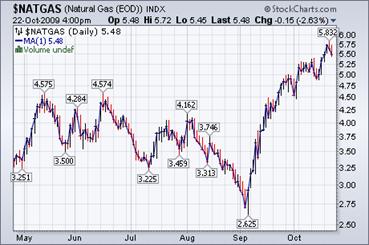 The Energy Information Agency’s Natural Gas Weekly Update reports, “Natural gas spot prices rose at market locations across the lower 48 States, with price increases ranging between $0.31 and $1.14 per MMBtu. Factors contributing to the hike in natural gas prices possibly included weather-related demand for natural gas, rising crude oil prices, and continuing injection demand for natural gas to exploit remaining arbitrage opportunities from storing gas.”
The Energy Information Agency’s Natural Gas Weekly Update reports, “Natural gas spot prices rose at market locations across the lower 48 States, with price increases ranging between $0.31 and $1.14 per MMBtu. Factors contributing to the hike in natural gas prices possibly included weather-related demand for natural gas, rising crude oil prices, and continuing injection demand for natural gas to exploit remaining arbitrage opportunities from storing gas.”
Conversataion with Art Cashin.
“…I said before St. Patrick's Day, we're probably gonna get a very, very strong rally. And sure enough, around March ninth, it started. And then around July, I said, okay, we've taken the end of the world premium away. I think they should flatten out and maybe even pull back a little bit until we see what the economy does. The market had other ideas.
…I think we started with what Mohamed El-Erian calls the second derivative, the change in the rate of change. Things were still getting not so hot, but the selling was slowing down. The slowness in the economy was slowing down.
That's all been changed. But most of it's been changed with the help of the government. We've had Cash For Clunkers, we've had special tax incentives for first time [home] buyers. And that's been good. It's moved things around. Now the question is, can the patient sustain himself, that being the economy, when he comes off life support. And there is some doubt out there about that.” (Read full text and see video clip.)
On October 9, 1930… Market wrap: Leading stocks “follow highly irregular course.” Market opened “as though the bottom was about to fall out” on bad rail and steel news. US Steel plunged to lowest level since 1928; many other stocks sank below previous 1930 support. Another bad break seemed in store, but pressure abruptly lifted by end of the first hour and action greatly improved. Rallying appeared in leading stocks, and some trading favorites were up sharply; disconcerted bears helped the movement along by covering shorts.
Our Investment Advisor Registration is on the Web
We are in the process of updating our website at www.thepracticalinvestor.com to have more information on our services. Log on and click on Advisor Registration to get more details.
If you are a client or wish to become one, please make an appointment to discuss our investment strategies by calling Connie or Tony at (517) 699-1554, ext 10 or 11. Or e-mail us at tpi@thepracticalinvestor.com .
Anthony M. Cherniawski,
President and CIO
http://www.thepracticalinvestor.com
As a State Registered Investment Advisor, The Practical Investor (TPI) manages private client investment portfolios using a proprietary investment strategy created by Chief Investment Officer Tony Cherniawski. Throughout 2000-01, when many investors felt the pain of double digit market losses, TPI successfully navigated the choppy investment waters, creating a profit for our private investment clients. With a focus on preserving assets and capitalizing on opportunities, TPI clients benefited greatly from the TPI strategies, allowing them to stay on track with their life goals
Disclaimer: The content in this article is written for educational and informational purposes only. There is no offer or recommendation to buy or sell any security and no information contained here should be interpreted or construed as investment advice. Do you own due diligence as the information in this article is the opinion of Anthony M. Cherniawski and subject to change without notice.
Anthony M. Cherniawski Archive |
© 2005-2022 http://www.MarketOracle.co.uk - The Market Oracle is a FREE Daily Financial Markets Analysis & Forecasting online publication.



